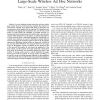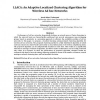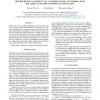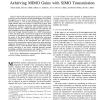INFOCOM
2012
IEEE
12 years 9 months ago
2012
IEEE
—In most existing wireless networks, end users obtain data content from the wired network, typically, the Internet. In this manner, virtually all of their traffic must go throug...
INFOCOM
2011
IEEE
13 years 10 months ago
2011
IEEE
—A practical protocol jointly considering PHY and MAC for MIMO based concurrent transmissions in wireless ad hoc networks, called Contrabass, is presented. Concurrent transmissio...
CEE
2011
13 years 10 months ago
2011
Performance of ad hoc networks dramatically declines as network grows. Cluster formation in which the network hosts are hierarchically part...
ICASSP
2011
IEEE
13 years 10 months ago
2011
IEEE
Wireless networks are fundamentally limited by the intensity of the received signals and the mutual interference caused by many concurrent transmissions. We consider large wireles...
TWC
2010
14 years 1 months ago
2010
The goal of this paper is to explore the benefits of channel diversity in wireless ad hoc networks. Our model is that of a Poisson point process of transmitters, each with a recei...
TWC
2010
14 years 1 months ago
2010
In wireless ad hoc networks, relative neighborhood graphs (RNGs) are widely used for topology control. If every node has the same transmission radius, then an RNG can be locally co...
JDCTA
2010
14 years 1 months ago
2010
In wireless ad hoc networks environment, Bellovin and Merritt first developed a password-based Encrypted Key Exchange (EKE) protocol against offline dictionary attacks using both ...
TCOM
2011
14 years 1 months ago
2011
—The benefit of multi-antenna receivers is investigated in wireless ad hoc networks, and the main finding is that network throughput can be made to scale linearly with the numb...
165
click to vote
SCN
2011
Springer
14 years 1 months ago
2011
Springer
An inelastic flow is a flow with inelastic rate: i.e., the rate is fixed, it cannot be dynamically adjusted to traffic and load condition as in elastic flows like TCP. Real ti...
ADHOC
2010
14 years 1 months ago
2010
In this paper, we investigate the low coverage problem of efficient broadcast protocols in wireless ad hoc networks with realistic physical layer models. To minimize energy consum...




